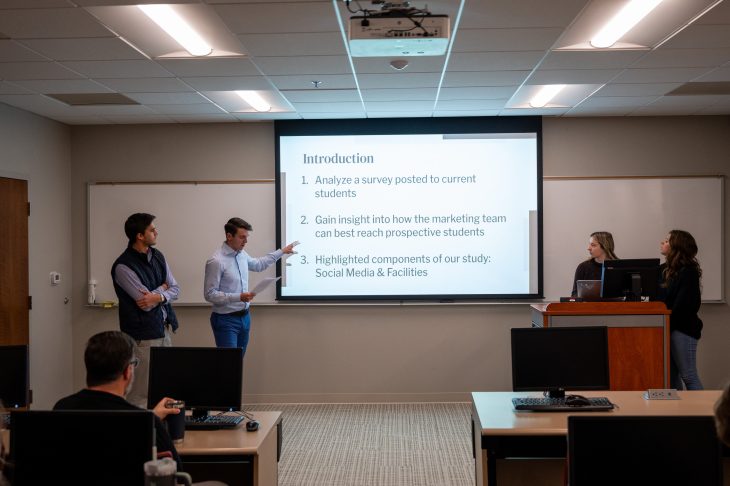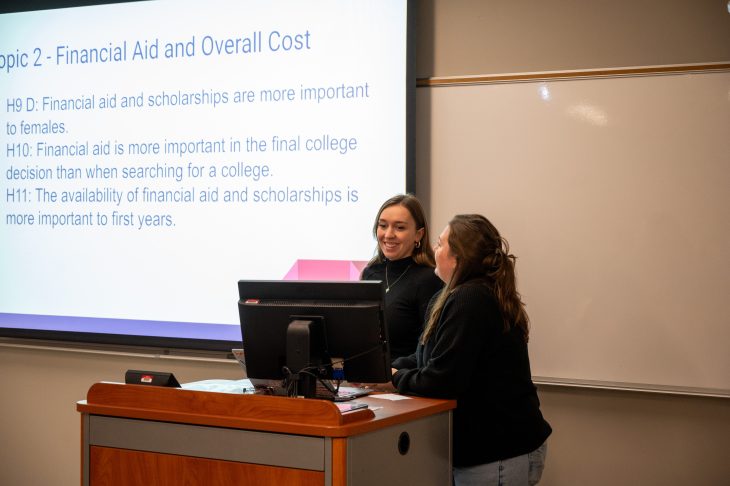
Market research classes are typically theoretical — students work with simulated data sets and make presentations for imaginary clients. But this fall, students in professor Becky Hochradel’s BA 3304 Marketing Research class had the atypical opportunity to partner with Transylvania’s Office of Marketing and Communications to do real-world research focused on why students choose to attend Transy.
Instead of working through a scripted case study, the students accepted the university’s marketing office as their “client” for the term. Julie Martinez, director of marketing and communications, and Stephen Russell, lead graphic designer, worked alongside the students to establish five focus groups composed of current students, faculty and staff, while Hochradel taught the class how to conduct market research, including various methods of data analysis. They then helped the students develop a survey to send to all Pioneers based on the information garnered in the focus groups.
“This was a really great opportunity for our office to collaborate with students in the marketing department to do research that we need for our work and give them real-world application experience as well,” Martinez said.
Nearly a quarter of the student population responded to the class’s survey, which asked a series of questions about sources of information during the college search, factors of various importance throughout a student’s college search, and which factor was most important in making a final college decision.
Marketing Research students then used those responses to explore relationships between different variables, including academic opportunities and reputation, athletic participation, class size, campus location, extracurricular activities, facilities and financial aid. They formulated and tested their hypotheses using SPSS, a software platform used for statistical data analysis.
While some of the project’s outcomes were expected, the students also uncovered correlations — or a lack thereof — that were more surprising.
“With real-world data and questions, things don’t always come out clean,” Russell acknowledged. “Part of the benefit to students of using real-world data is that it gives them better experience than just working with sample data. It gives them a better idea of how this actually works in the real world.”
The term-long project culminated with group presentations given by the student researchers to members of the Marketing and Communications team.

While Martinez and Russell appreciated the data gathered by the students, they also found value in learning alongside them — part of what makes a small-school experience so special for students and employees alike.
“Getting to be with students and be part of their learning process and give them real-world experience is a wonderful thing,” Russell said.
“I was very impressed with our students throughout the semester,” Martinez agreed, adding that she appreciated the engagement of both the course participants and the students who attended the focus groups. “They exemplified how thoughtful and insightful our students tend to be.”
The class members likewise appreciated the unique opportunity to work with the marketing team.
“When starting this research project, I was completely unaware of how much knowledge I would gain in the field of marketing,” said Logan Thomas ’24.
Many of the students in Marketing Research will be building on their work with this data set next term in Hochradel’s Consumer Behavior class.
Not only will these students take what they learned into future classes, but they will use the skills honed in this course in their future careers.
“Through my marketing research class, I’ve learned to navigate through data and study further into the factors that impact a student’s decision when choosing a university,” said Jaylan Green ’24. “It was great to use real-life data to help my university, while it provided me with a valuable perspective to use in my approach to marketing.”

